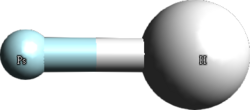Physics:Positronium hydride
Positronium hydride, or hydrogen positride[1] is an exotic molecule consisting of a hydrogen atom bound to an exotic atom of positronium (that is a combination of an electron and a positron). Its formula is PsH. It was predicted to exist in 1951 by A Ore,[2] and subsequently studied theoretically, but was not observed until 1990. R. Pareja, R. Gonzalez from Madrid trapped positronium in hydrogen laden magnesia crystals. The trap was prepared by Yok Chen from the Oak Ridge National Laboratory.[3] In this experiment the positrons were thermalized so that they were not traveling at high speed, and they then reacted with H− ions in the crystal.[4] In 1992 it was created in an experiment done by David M. Schrader and F.M. Jacobsen and others at the Aarhus University in Denmark . The researchers made the positronium hydride molecules by firing intense bursts of positrons into methane, which has the highest density of hydrogen atoms. Upon slowing down, the positrons were captured by ordinary electrons to form positronium atoms which then reacted with hydrogen atoms from the methane.[5]
Decay
PsH is constructed from one proton, two electrons, and one positron. The binding energy is 1.1±0.2 eV. The lifetime of the molecule is 0.65 nanoseconds. The lifetime of positronium deuteride is indistinguishable from the normal hydride.[4]
The decay of positronium is easily observed by detecting the two 511 keV gamma ray photons emitted in the decay. The energy of the photons from positronium should differ slightly by the binding energy of the molecule. However, this has not yet been detected.[1]
Properties
The structure of PsH is as a diatomic molecule, with a chemical bond between the two positively charged centres. The electrons are more concentrated around the proton.[6] Predicting the properties of PsH is a four body Coulomb problem. Calculated using the stochastic variational method, the size of the molecule is larger than dihydrogen, which has a bond length of 0.7413 Å.[7] In PsH the positron and proton are separated on average by 3.66 a0 (1.94 Å). The positronium in the molecule is swollen compared to the positronium atom, increasing to 3.48 a0 compared to 3 a0. Average distance of the electrons from the proton is larger than the dihydrogen molecule, at 2.31 a0 with the maximum density at 2.8 au.[1]
Formation
Due to its short lifetime, establishing the chemistry of positronium hydride poses difficulties. Theoretical calculations can predict outcomes. One method of formation is through alkali metal hydrides reacting with positrons. Molecules with dipole moments greater than 1.625 debye are predicted to attract and hold positrons in a bound state. Crawford's model predicts this positron capture. In the case of lithium hydride, sodium hydride and potassium hydride molecules, this adduct decomposes and positronium hydride and the alkali positive ion form.[8]
Similar compounds
PsH is a simple exotic compound. Other compounds of positronium are possible by the reactions e+ + AB → PsA + B+.[9] Other substances that contain positronium are di-positronium and the ion Ps− with two electrons. Molecules of Ps with normal matter include halides and cyanide.[6]
References
- ↑ 1.0 1.1 1.2 Usukura, J.; K. Varga; Y. Suzuki (22 Apr 1998). "Signature of the existence of the positronium molecule". Physical Review A 58 (3): 1918. doi:10.1103/PhysRevA.58.1918. Bibcode: 1998PhRvA..58.1918U.
- ↑ Usukura, J.; Varga, K.; Suzuki, Y. (1998). "Signature of the existence of the positronium molecule". Physical Review A 58 (3): 1918. doi:10.1103/PhysRevA.58.1918. Bibcode: 1998PhRvA..58.1918U.
- ↑ "FY 1992 Accomplishments - "Out of This World" Chemical Compound Observed". p. 9. http://science.energy.gov/~/media/bes/pdf/accomplishments/files/bes_accomp_fy1992.pdf.
- ↑ 4.0 4.1 Monge, M. A.; R. Pareja; R. González; Y. Chen (1996). "Positronium deuteride and hydride in MgO crystals". Journal of Radioanalytical and Nuclear Chemistry 211 (1): 23–29. doi:10.1007/BF02036251. ISSN 0236-5731. https://zenodo.org/record/1232518.
- ↑ Schrader, D. M.; Jacobson, Finn M.; Niels-Peter, Niels-Peter; Mikkelsen, Ulrik (1992). "Formation of Positronium Hydride". Physical Review Letters 69 (1): 57–60. doi:10.1103/PhysRevLett.69.57. PMID 10046188. Bibcode: 1992PhRvL..69...57S.
- ↑ 6.0 6.1 Saito, Shiro L. (2000). "Is Positronium Hydride Atom or Molecule?". Nuclear Instruments and Methods in Physics Research B 171 (1–2): 60–66. doi:10.1016/s0168-583x(00)00005-7. Bibcode: 2000NIMPB.171...60S.
- ↑ "Bond lengths and dissociation enthalpies of diatomic molecules". National Physics Laboratory Kaye and Laby tables of physical and chemical constants. http://www.kayelaby.npl.co.uk/chemistry/3_7/3_7_2.html.
- ↑ Oyamada, Takayuki; Masanori Tachikawa (2014). "Multi-component molecular orbital study on positron attachment to alkali-metal hydride molecules: nature of chemical bonding and dissociation limits of [LiH; e+]". The European Physical Journal D 68 (8): 231. doi:10.1140/epjd/e2014-40708-4. ISSN 1434-6060. Bibcode: 2014EPJD...68..231O.
- ↑ Schrader, D. M. (1992). "Positronium hydride formation in collisions of positrons with molecular hydrogen". Theoretica Chimica Acta 82 (5): 425–434. doi:10.1007/BF01113943. ISSN 0040-5744.
 |


